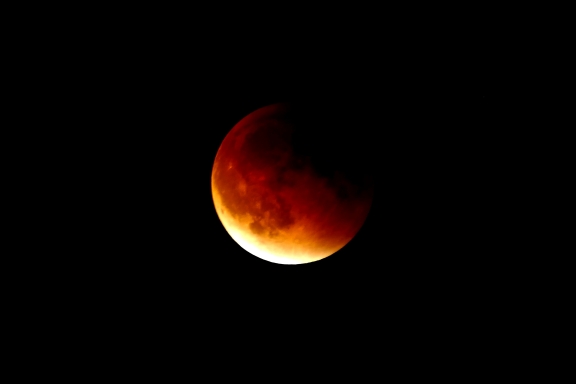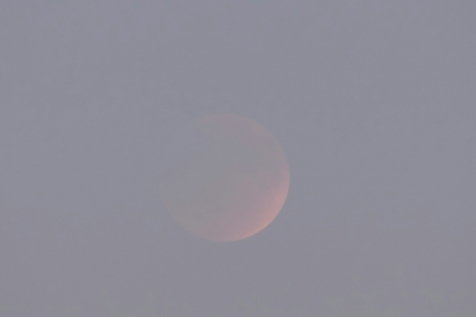
I went to Magnuson Park to watch and photograph the lunar eclipse last night, along with several hundred other Seattleites. It was quite the experience.
I still vividly remember my first lunar eclipse. My first job in Seattle was as a delivery driver on graveyard shift. It was in the wee hours, near the beginning of my route, and I started getting a little freaked out because the moon seemed to be slowly disappearing. It finally dawned on me what was happening, but it took a while for the realization.
Since then I’ve seen several partial eclipses. While I now know immediately what is happening, it’s still a rather spooky experience. Sunday was the first time I’ve ever set out specifically with a plan to watch an eclipse.
I did a good job of timing my arrival at Magnuson. Moonrise was at 6:54 pm. I got to the park at about 6:15 and easily found a parking space close to my destination near the boat launch. There were quite a few people already there, some having set up family picnics, but that was no hint as to the crowds yet to come.
I had expected other people, but had absolutely no idea that literally thousands would be flocking to parks around the city. It felt like I was at a fireworks display or an outdoor concert. The lawn filled up with chairs and blankets and many more people sat on logs and stood in groups. At the end the outdoor concert vibe was enhanced as bumper to bumper cars left the park’s several parking lots in an endless stream of headlights.
When waiting for the start no one around me seemed to know where on the horizon the moon would come up, so everyone just kept scanning for the first sighting. Long past the time of moonrise there was still no sign of the moon.
Finally someone called out, “There it is.”
There was so much haze on the horizon and the sky was still so light from the just set sun that the moon wasn’t visible at all as it first rose above the mountains. It was a ways above the horizon by the time it was sighted, and extremely faint since it was already in full eclipse. As the sky darkened and the moon rose higher it became more and more visible to the naked eye.
Meanwhile I started taking photos. The moon was much more distinct with my camera than with my eyes, as the telephoto lens helped cut through the haze, and the bloodmoon red was quite apparent on the view screen after adjusting for exposure.
I had come prepared, or so I thought. I had my sturdy tripod set up. The wireless remote shutter release was attached and functioning properly. After a few tests and adjustments I was happy with ISO, aperture, and shutter speed.
Unfortunately, I apparently suck at focusing during a lunar eclipse. My autofocus was useless. Too little light being reflected from the moon was giving my camera a mini nervous breakdown, so I thought no big deal and switched to manual focus.
But despite checking focus several times, almost all of my photos are blurry. Only the two posted here as sunlight was returning to the moon actually turned out kinda sorta sharp. Most of my pretty bloodmoons are blobby. (Insert some disappointed photographer tears here.)
Edit to add: I have since learned that the problem wasn’t focus but motion blur! I was shooting at around 5-6 seconds, but the moon moves too quickly across the sky for that when using a telephoto lens. Depending on focal length, two seconds is the longest you can safely use. For really long lenses you need to get it down to one second or less.)
Halfway through I also discovered that I had accidentally set the exposure compensation. (On my camera that setting is extremely easy to change when not intending to. Very frustrating.) So all the pics that looked perfectly exposed on my camera screen were actually too dark! And of course, I could not figure out how to change the setting back to normal in the dark.
At least I wasn’t having as much trouble as the couple standing behind me. They arrived very late and they both had fancy cameras, but neither of them seemed to know anything. They kept up a running conversation about nothing on their cameras working and how do they fix it. One of them kept using flash until I finally said something to them, irritated by the bursts of blinding white light. (They didn’t seem aware of the fact a flash will not illuminate an object located 225,000 miles away. Or maybe they just didn’t know how to turn it off.)
The moral to my story and theirs is: know your camera really well before using it in the dark. I now have to wait until 2018 to try and do better.
The night can’t be considered a loss though. Despite my usual dislike of crowds, it was a good feeling to be gathered in a communal spirit to enjoy a special evening outdoors. Everyone was very friendly and a good time was had by all. The moon was eerie and beautiful.

The mountain was out.

Before the crowds showed up.

What the moon looked like when first seen.

After adjusting for exposure with the light sky. But too dark!

Too blurry!

Sunlight returns to the moon.
Something is better than the bubkus I got, though I expected it. I just upgraded to a DSLR (and manual mode) in June and don’t have a tripod or a remote shutter release…so you can imagine how that went. I am happy to report that I gave up pretty quickly and just enjoyed the view (we, too, felt a 4th of July vibe) and didn’t try a flash or anything ridiculous like that. 🙂
LikeLike
I’m sorry that you didn’t get anything good, but it’s comforting to hear I’m not the only one flailing around out there. We have a little over two years to practice so we can get it right next time!
Camera stuff is great for holiday wishlists. I got my remote for Christmas last year, and this year I’m putting a red bulb flashlight on my list so I can see my camera controls in the dark without killing night vision.
LikeLike
p.s. on the remote: Amazon has a few decent remotes for about half the price of what one from a camera’s manufacturer costs.
LikeLike
The list is never-ending…and long…and expensive…and I’m not exactly consistent with what I have, so I’m trying not to go overboard too soon.
LikeLike
I was at Green Lake with probably a hundred people at the dock I was near. I saw it just fine but my iPhone didn’t take good pics either 😉 And there were several people that took flash photos at Green Lake too but they all only made that mistake once and turned off their flash.
At least we all got to see it! Very fun.
LikeLike
Great to hear you had a nice time too! You really can’t get a decent pic of the moon without a telephoto. Goodness knows I used to try though.
LikeLiked by 1 person
I laughed so hard about the couple with the blinding flash…..too funny! I could definitely picture it! I did a practice photo shoot the night before and got so frustrated with my camera settings that I gave up on shooting the real thing. I did read up on it….what I was doing wrong, which was everything….LOL Still haven’t figured it all out, but hopefully I will be ready for 2018 if I am fortunate to witness the next one. I just sat back and enjoyed the eclipse with my binoculars. Hugs
LikeLike
That’s one of the biggest problems with digital photography. With my film SLR all I had to do was turn the f-stop ring until the shutter speed I wanted was displayed, focus, and ta-da, I had a picture. And focusing was sooo much easier with the split prism. But with digital you not only have to understand basic photography concepts, you have to learn about a million buttons and settings to get what you want. On the other hand, I LOVE the convenience of digital and the freedom to experiment without worrying about film processing costs.
Here’s to a more successful 2018!
LikeLike
Your photos turned out really good! I love the first one at the top of the post and the bottom one where the moon is tri-colored. I didn’t get one good photo. All of mine are really blurry. I used my tripod and the 10 second delay function since I don’t have a remote. I’ve gotten photos of other moons this way but could not get clear shot of the eclipse. I was over at the school next door all alone. Your experience sounds much more enjoyable, aside from that couple blinding you with their flash!
LikeLike
I’ve since seen photos from others that were blurry too. I’m wondering if maybe even 5-6 seconds is too long an exposure time for the movement of the moon. I’ll have to read up on it. When the moon is fully lit you use a much faster shutter speed. I had ISO set to 125 to avoid noise, but I think next time I’ll bump that up to try and get closer to a 1 second shutter speed.
I also used the 10 second delay for tripod photos before I got the remote as a Christmas gift last year.
LikeLike
What a wonderful experience! I don’t think your photos are blurry. I didn’t understand what was happening, either, until the eclipse started to pass — when I saw the sliver of light increasing then I understood that the moon had been in the earth’s shadow. This was the most dramatic eclipse I had ever seen, and I am 63! Wonders of the earth and sky.
LikeLike
It was the most dramatic for me too. Wonders for sure.
LikeLike
That was a magical night for me. Just stunning and we had zero crowd where we were. It was truly awesome.
LikeLike
Yes, I saw your post. Glad we all got to experience it.
LikeLike
Pingback: Seattle: Magnuson Park Pt. 5 – Promontory Point | Park Preview
Pingback: Total Lunar Eclipse 2019 | Park Preview